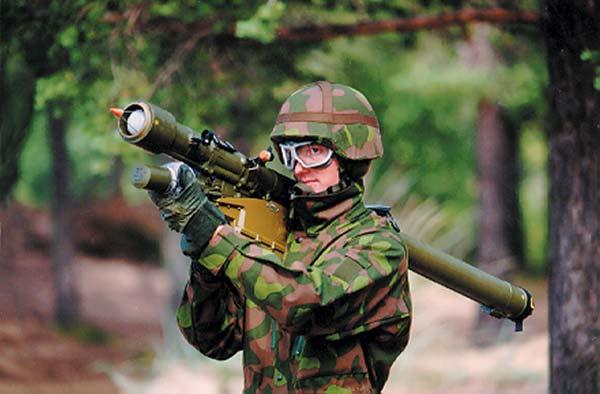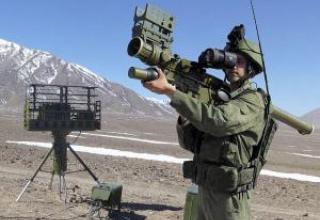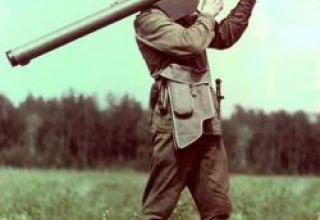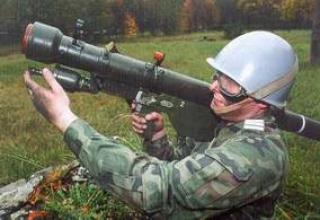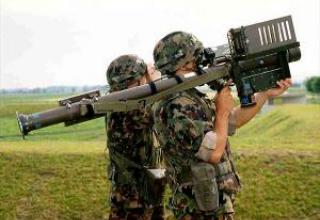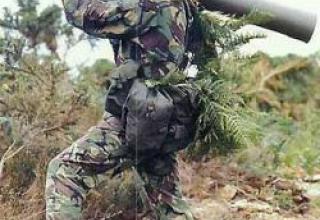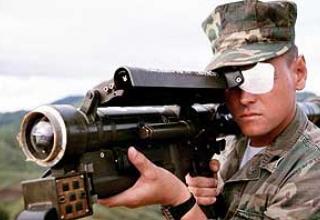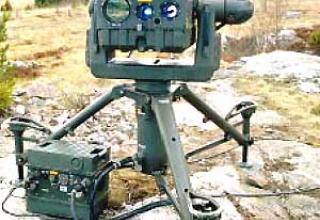In order to provide the Ground Forces with accelerated equipping with highly effective weapons in accordance with the decision of the MIC of May 6, 1978 ¹ 114, simultaneously with the development of the Igla complex in the Heavy Machine Building Design Bureau (Kolomna), work was started on the creation of a simplified portable SAM system "Igla-1" with the use of modified thermal GSN from the missile system "Arrow-3".
Joint tests of the 9K310 "Igla-1" complex were conducted from January 15 to July 9, 1980 at the Dongguz range under the guidance of a commission headed by Yu. The complex was adopted by the Decree of the CPSU Central Committee and the USSR CM of March 11, 1981.
Series production of 9K310 complex combat vehicles, as well as all other portable SAMs, was carried out at the Kovrov plant. Degtyarev MOS, and tablet 1L15-1 was produced at the Izhevsk Electromechanical Plant MRP.
In the west, the complex was designated SA-16 "Gimlet" .
Composition:
It is part of the complex:
- missile 9M313;
- launch tube 9P322;
- 9P519 launcher with 1L14 ground radar requestor;
- portable electronic tablet 1L15-1;
- mobile control point and a set of equipment for bases and arsenals.
Compared to the portable Arrow-3 SAM system, the probability of hitting one F-4 fighter missile flying at 310 m/sec at 310 m/sec increased from 0.09 to 0.59, inhalation (at target speed 260 m/sec) - from 0.07 to 0.44. Maximum target velocity increased from 310 to 360 m/s when shooting towards, from 260 to 320 m/s - from inhaling. The upper boundary of the kill zone increased from 2200 to 2500 m.
The above mentioned advantages of the Igla-1 complex as compared to the Strela-3 portable SAM system were achieved by implementing the following new technical solutions.
In order to improve the SAM guidance dynamics at the predetermined meeting point for the purpose of thermal GSN, an additional scheme was introduced, forming a command to turn the missile at the initial flight area, and an electronic switch of modes "inhalation" - "towards". Miniature pulse solid-fuel engines were installed in the rocket's steering compartment to ensure a postlaunch turnaround.
An explosive substance with increased blast effect was used in the combat unit of the SAM. The SAM fuse had an induction sensor (vortex generator), which ensures that the BC is detonated when the missile passes near the metal shell of the target. In a direct hit, the BC was detonated by a duplicate contact fuse. A tube with an explosive substance was inserted into the fuse to transfer the detonation from the BC charge to the charge of the explosive generator first installed on the SAM to detonate the remaining fuel of the missile's marching engine.
To reduce aerodynamic resistance, a small conical fairing was placed in front of the thermal CNS, attached to three inclined rods forming a kind of "tripod". In order to improve the dynamic performance, a destabilizer was installed on the rocket in a plane perpendicular to the aerodynamic rudders. The use of vane stabilizers in the transport position adjacent to the side surface of the tail of the rocket body allowed a more rational use of the launch tube volume, previously occupied by folded fountain stabilizers.
A 1L14 requestor was built into the launch mechanism, providing target identification and auto-locking of ZUR launch by its aircraft. The need to equip portable SAMs with small-size ground-based radar transponders (GPRs) was justified in 3 Research Institute of the Moscow Region by a division headed by A.S. Baturin. Its staff also contributed to the creation of a prototype of the 1L14 requestor in the Research Institute of Small-Scale Ground-Based Radar Receiver, which, with azimuth resolution of 20°-30°, ensured the identification of targets with a frequency of at least 0.9, which practically excluded launches of SAMs at their facilities. However, due to the large width of the antenna's directional pattern (up to 30° azimuth and up to 70° angle), as well as due to the presence of the rear petals of this pattern, the shooter could trigger from the responder of his aircraft flying near the man-portable air defense system and block the launch of the missile at the enemy. In such cases, the shooter could disable the launch lock.
The external difference of the man-portable air defense system was the blunted conical front cover of the launch tube, as well as the location of the power supply unit and the balloon at an angle to the longitudinal axis of the launch tube.
Complex "Igla-1" was supplemented with a portable electronic tablet 1L15-1 commander of the anti-aircraft gunners department, also for the first time proposed by employees of 3 Research Institute of Defense and designed to alert the commander of the department of the air situation in a square 25 x 25 km. The presence of a target in this square, to which in a rectangular system of coordinates referenced points of position of the source of information and separation of anti-aircraft gunners, as well as the position of the target was displayed on the display tablet tanning the corresponding target position of the light indicator element. The source of information for the tablet could be the air defense control points in the "division regiment" link (PU-12, PU-12M, PU-1, PU-1M), radar P-19 or "Dome", used at the division's air defense chief's PU, equipped with telecode equipment for data acquisition and transmission ASPD-U. The tablet prototype provided stable target designation reception from the control point PU-12M at a range of at least 10 km. The tablet was tied to the terrain by the commander of the anti-aircraft gunners' department with the help of a compass at the reference point specified from the PU-12M, which provided the target coordinates reception with the accuracy not worse than 1000 m in range and 5°-25° in azimuth. Errors of target designation without a tablet (issued by radio phone with PP-12M directions to targets in the world relative to the point of standing PP-12M) were up to 5 km in range and 40 ° azimuth. The tablet reflected up to four targets with marks about their nationality and the target's flight course relative to the position of anti-aircraft gunners.
The commander of the branch, having found out display of a target on a tablet, on radio station R-147 or a voice transmitted target designations (sector of search and distance to a target) to the shooters equipped with radio receivers R-147P, and also a hand indicated a direction of search. When firing towards the target, the shooters were visually detected at the range of 4.7 km with the frequency of 0.9 (without the tablet - at the range of 3-4 km with the frequency of 0.4-0.5). In difficult air conditions, the shooters' compartment using a tablet could only pass 3 targets out of 50, and without the tablet - 20 targets. When detecting his aircraft, the commander warned the shooters in time.
The dimensions of the tablet were 345 x 240 x 170 mm, weight - about 7 kg, time of transfer from marching to combat - about 3 minutes. Power was supplied from six A343 electric cells.
At the same time, recommendations were made to further improve the complex. Such recommendations included:
- ensuring the protection of portable SAMs from all types of thermal interference;
- increasing the range of fire at targets on counter courses:
- Ensuring firing under night conditions.
Igla-1" portable SAM system was exported abroad and used in local combat operations.
According to published data, the majority of aviation losses of multinational forces in the 1991 war were related to the use of man-portable SAM systems by Iraqis. In particular, they shot down four AV-8B Harier vertical take-off and landing aircraft.
Characteristics:
| Defeat zone, km: - in range (inhaling/attacking) - in height (inhaling/attacking) - as defined in |
1..5,0/0,5..3,3 0,01..2,5/0,01..2 for 2,5 |
| Probability of hitting a single ZUR fighter. | 0,44..0,59 |
| Maximum target speed (inhaling/attacking) m/s | 360/320 |
| ZUR flight speed, m/s | 600 |
| Mass of the rocket, kg | 10,8 |
| Weight of combat unit, kg | 1,17 |
| The length of the rocket, mm | 1673 |
| The diameter of the rocket body, mm | 72 |
Testing:
During the war with Iran, Iraq used HOT missiles, launching them from ground armored vehicles as well as helicopters. In the 1980s. "HOT was used in Lebanon by Syrians who destroyed several Israeli tanks such as Merkava. The complex was used by multinational forces during Operation Desert Storm.
Sources:
- Зенитные ракетные комплексы ПВО СВ. Техника и вооружения №5-6.99
- Вестник ПВО
- Russian Missile Systems - www.wonderland.org.nz
